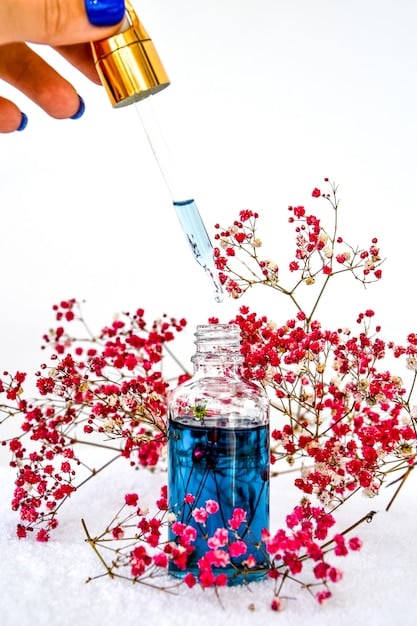Decoding Perfume Ingredients: Allergens and Sensitizers Guide

Decoding Perfume Ingredients: Understanding Common Allergens and Sensitizers is essential for individuals with sensitive skin or allergies, as perfumes can contain numerous ingredients that trigger adverse reactions, ranging from mild skin irritation to more severe allergic responses.
Ever wondered why a seemingly delightful fragrance leaves your skin itchy or triggers a headache? Decoding Perfume Ingredients: Understanding Common Allergens and Sensitizers is crucial for anyone who enjoys wearing fragrances but is also mindful of potential adverse reactions. Let’s dive into the hidden world of perfume ingredients to help you make informed choices.
Understanding Perfume Composition
Perfumes are complex mixtures carefully crafted to evoke specific scents. However, this complexity also means a higher chance of including ingredients that can cause allergic reactions or sensitivities. Understanding the basic components of a perfume is the first step in identifying potential irritants.
The Basic Building Blocks of Perfumes
Perfumes typically consist of fragrance oils, aroma compounds, fixatives, and solvents. Each plays a unique role in the final product:
- Fragrance Oils: These provide the main scent of the perfume and can be derived from natural sources like plants and animals, or created synthetically.
- Aroma Compounds: These are individual chemicals that, when combined, create a specific fragrance note.
- Fixatives: These substances reduce the evaporation rate of the fragrance oils, making the scent last longer.
- Solvents: Usually alcohol, solvents help to dilute and blend the other ingredients.
It’s the combination of these elements that gives each perfume its unique character, but it’s also this complexity that can lead to allergic reactions.

When it comes to safeguarding your skin and overall health, paying attention to the details of perfume composition can make a significant difference in ensuring a pleasant and safe fragrance experience.
Common Allergenic Ingredients in Perfumes
Certain ingredients are notorious for causing allergic reactions in sensitive individuals. Identifying these common allergens can help you avoid products that might trigger unwanted symptoms. This section will dive into some of the most frequently reported culprits.
Identifying the Usual Suspects
- Linalool: A naturally occurring alcohol found in many essential oils, linalool can cause allergic contact dermatitis.
- Limonene: Another common component of citrus oils, limonene can also irritate the skin.
- Cinnamal: Derived from cinnamon bark, this aldehyde is a known allergen.
- Eugenol: Found in clove oil, eugenol can cause skin irritation and allergic reactions.
These are just a few of the many ingredients that might cause problems. Always check the ingredient list for these and other potential allergens.
Being informed about common allergenic ingredients is a vital step in enjoying perfumes without the risk of adverse reactions. Knowledge empowers you to make safer choices.
Understanding Sensitizers
Sensitizers are substances that don’t necessarily cause an immediate allergic reaction, but can lead to increased sensitivity over time. Repeated exposure to these ingredients can result in the development of allergies. This is an important distinction, as it means even a perfume you’ve used for years could suddenly become problematic.
How Sensitization Works
Sensitization involves the immune system’s response to certain chemicals. With each exposure, the body becomes more reactive, eventually leading to an allergic response. Common sensitizers in perfumes include:
- Oakmoss Extract: A natural ingredient used for its woody, earthy scent, it’s a well-known sensitizer.
- Isoeugenol: Similar to eugenol, isoeugenol can also lead to increased sensitivity with prolonged use.
- Hydroxyisohexyl 3-Cyclohexene Carboxaldehyde (HICC): Also known as Lyral, this synthetic fragrance has been restricted due to its sensitizing potential.
Avoiding sensitizers is key to preventing long-term allergic issues. Always be vigilant about the ingredients in your perfumes.

Understanding the concept of sensitization helps you to make informed decisions about the perfumes you choose and to minimize the risk of developing allergies over time.
Decoding Ingredient Lists
Ingredient lists can be daunting, full of unfamiliar chemical names. However, knowing how to interpret these lists is a crucial skill for anyone concerned about allergens and sensitizers. This section provides a guide to navigating perfume ingredient lists effectively.
Tips for Reading Labels
- Look for Specific Names: Rather than vague terms like “fragrance,” try to identify specific chemicals.
- Be Aware of Common Synonyms: Some ingredients have multiple names; familiarize yourself with these.
- Understand Concentration Matters: Higher concentrations of allergens are more likely to cause reactions.
Take the time to research any ingredients you’re unsure about. Several online databases can provide information on the potential allergenic properties of various chemicals.
With a little practice, you can become proficient at decoding ingredient lists and making smarter choices about the perfumes you wear.
Symptoms of Perfume Allergies and Sensitivities
Recognizing the symptoms of perfume allergies and sensitivities is essential for identifying potential problems early on. Reactions can vary from mild irritation to more severe allergic responses.
Common Reactions to Perfumes
Symptoms can manifest in several ways, including:
- Skin Irritation: Redness, itching, and hives are common signs of contact dermatitis.
- Respiratory Issues: Sneezing, coughing, and difficulty breathing can occur in some individuals.
- Headaches: Certain fragrances can trigger migraines or headaches in sensitive people.
- Eye Irritation: Watery, itchy eyes can also be a symptom of a perfume allergy.
If you experience any of these symptoms after using a perfume, discontinue use immediately and consult a healthcare professional if necessary.
Prompt recognition of symptoms can help you take timely action to prevent further discomfort and potential health complications.
Safe Alternatives and Precautions
If you’re concerned about potential allergic reactions, there are several safe alternatives and precautions you can take. From fragrance-free products to patch testing, this section provides practical tips for enjoying fragrances safely.
Practical Steps for a Safer Fragrance Experience
You can minimize the risk of adverse reactions by:
- Choosing Fragrance-Free Products: Look for perfumes labeled “fragrance-free,” which should not contain any added scents.
- Opting for Natural Perfumes: Natural perfumes often use fewer synthetic chemicals, reducing the risk of sensitivity.
- Performing a Patch Test: Apply a small amount of perfume to a discreet area of skin and wait 24-48 hours to see if any reaction occurs.
Additionally, consider consulting with a dermatologist or allergist for personalized advice and testing.
Taking these precautions ensures that your fragrance experience remains enjoyable and safe, without compromising your health.
| Key Point | Brief Description |
|---|---|
| ⚠️ Common Allergens | Ingredients like linalool, limonene, and cinnamal can cause allergic reactions. |
| 🧪 Sensitizers | Substances like oakmoss extract can increase sensitivity over time. |
| 🧐 Decode Labels | Learn to read and understand perfume ingredient lists to identify potential allergens. |
| ✅ Safe Alternatives | Opt for fragrance-free or natural perfumes, and always do a patch test. |
[Frequently Asked Questions]
▼
Common signs include skin irritation like redness, itching, hives, respiratory issues, headaches, and watery eyes. If you experience any of these, discontinue use immediately.
▼
An allergy involves an immediate immune response, while a sensitivity develops over time with repeated exposure, leading to increased reactivity to certain ingredients.
▼
Check the ingredient list for specific names like linalool, limonene, cinnamal, and eugenol. Research any unfamiliar ingredients to understand their potential allergenic properties.
▼
Natural perfumes often use fewer synthetic chemicals, which can reduce the risk of sensitivity. However, some natural ingredients can still cause allergic reactions, so always patch test.
▼
Perform a patch test by applying a small amount to a discreet area and waiting 24-48 hours. Monitor for any signs of irritation or allergic reaction before widespread use.
Conclusion
In summary, understanding perfume ingredients, recognizing common allergens and sensitizers, and taking appropriate precautions are vital for enjoying fragrances safely. By decoding ingredient lists, knowing the symptoms of allergic reactions, and opting for safer alternatives, you can protect your health and continue to indulge in the world of perfumes with confidence.





